Abstract
Unlike laboratory animals, people are rarely exposed to a single hazardous chemical. However, most of the information documenting adverse human health effects from environmental and occupational contaminants has come from studies focused on exposure to single chemicals, and there is little information available on how two or more contaminants affect humans. Most information on the effects of mixtures comes from animal systems and limited investigations of isolated human cells in culture, even though the study of mixtures in such systems has also been neglected. Two or more compounds may show additive, antagonistic, or synergistic interactions or may act on totally different systems and thus not interact. Furthermore, even a single chemical may have multiple effects and affect more than one organ system. Effects may vary with age, and metabolites may have totally different actions from the parent compound. This paper will review the variety of health effects in humans that may result from environmental contaminants and discuss how such contaminants may interact with each other. We will also present examples on how different contaminants interact from toxicologic studies of polychlorinated biphenyls performed as part of our Albany, New York, Superfund Basic Research Program project.
Full text
PDF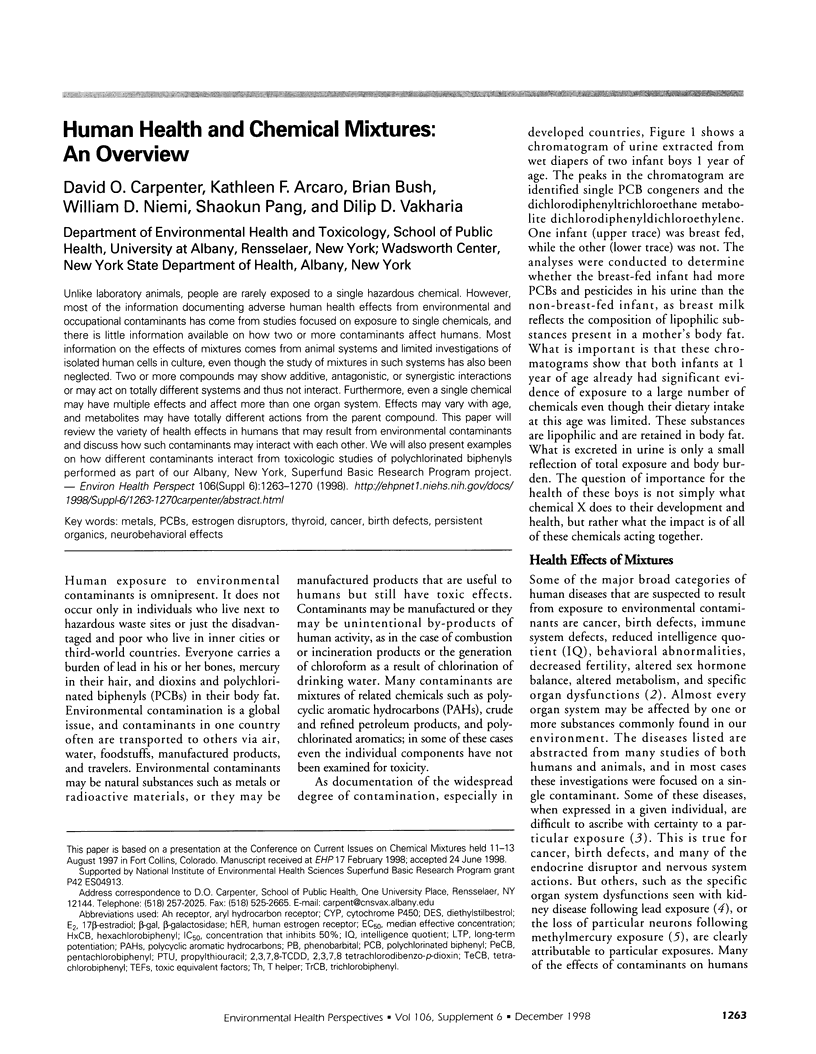
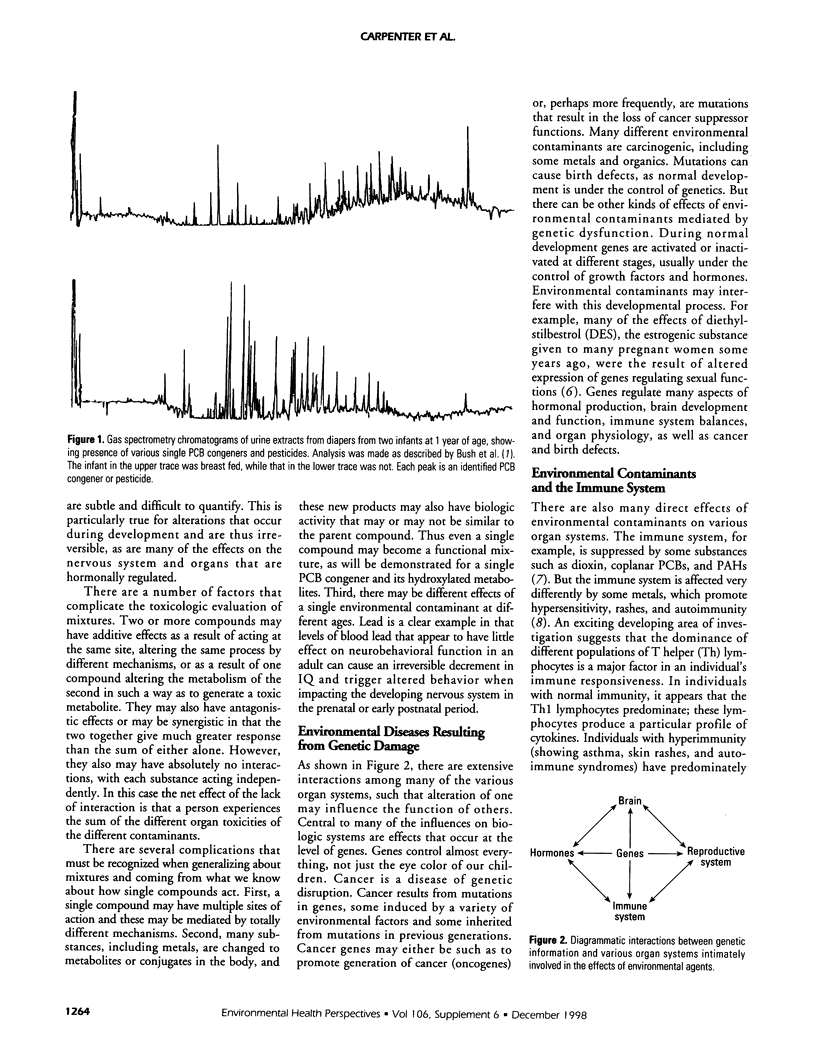
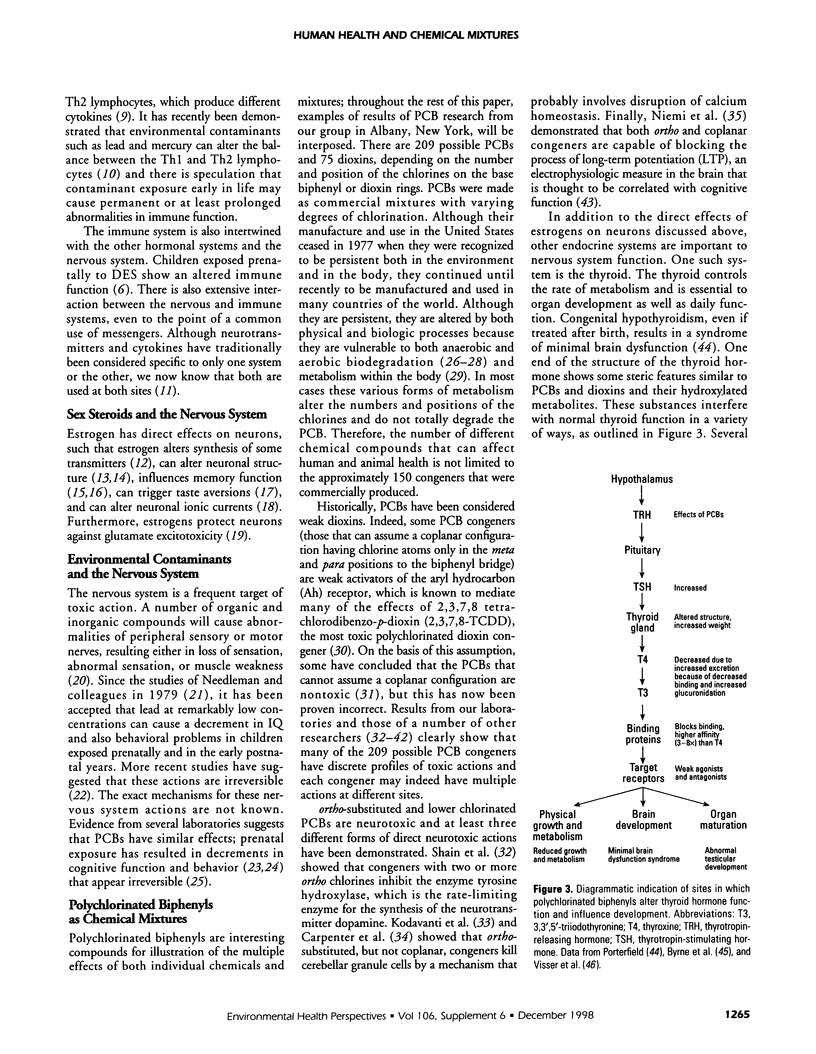
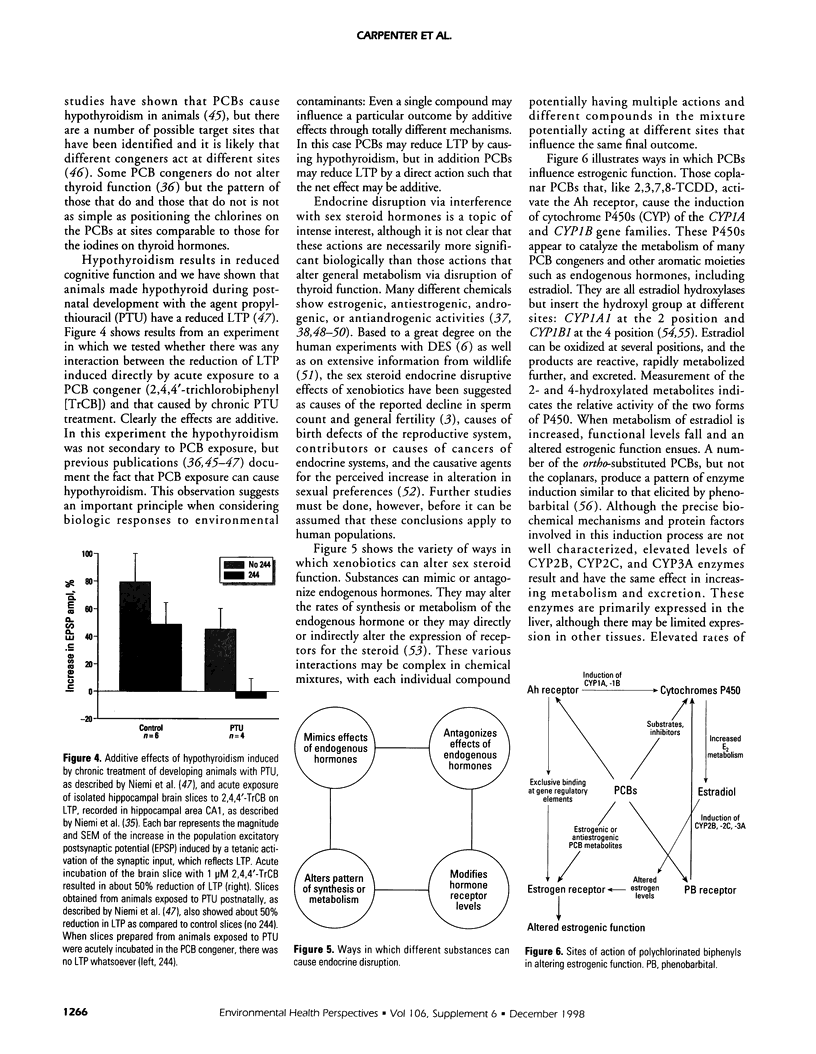
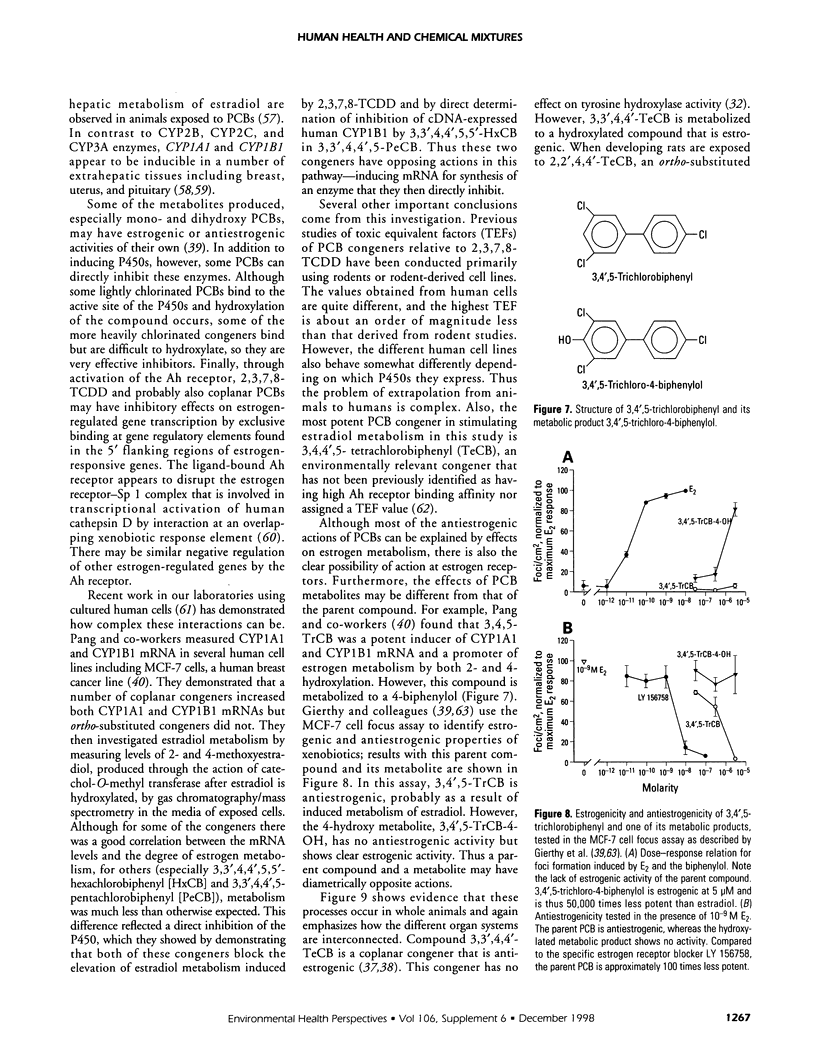
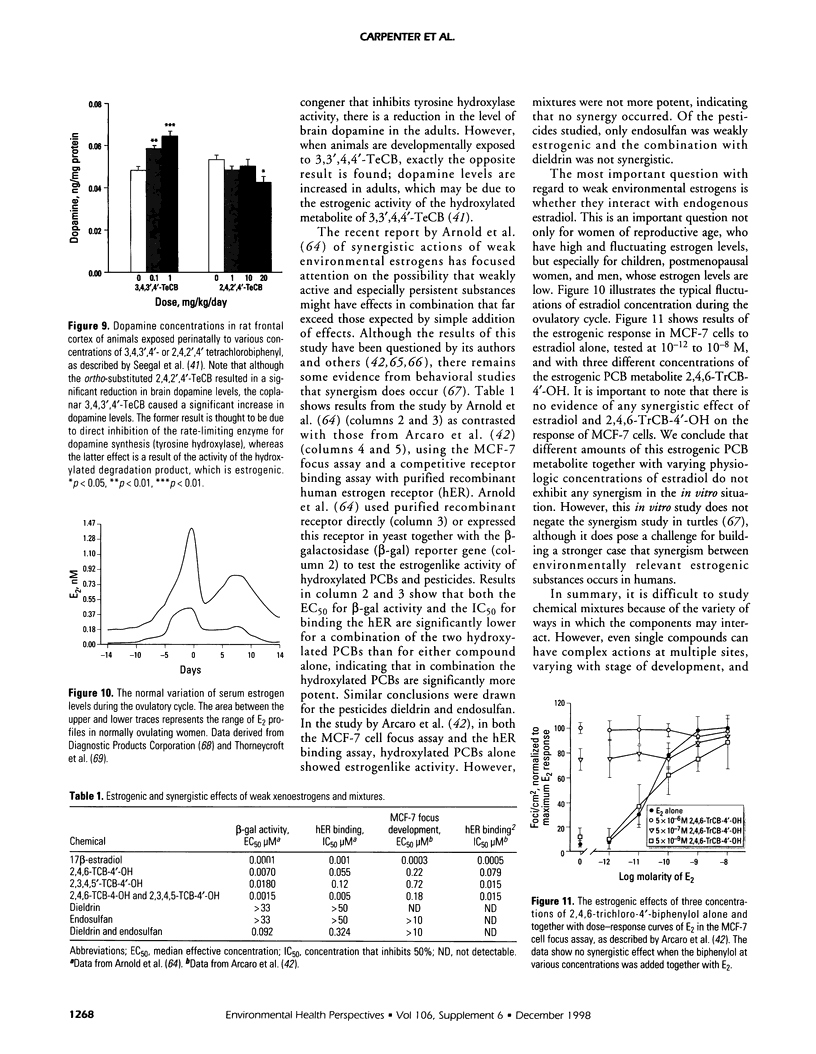
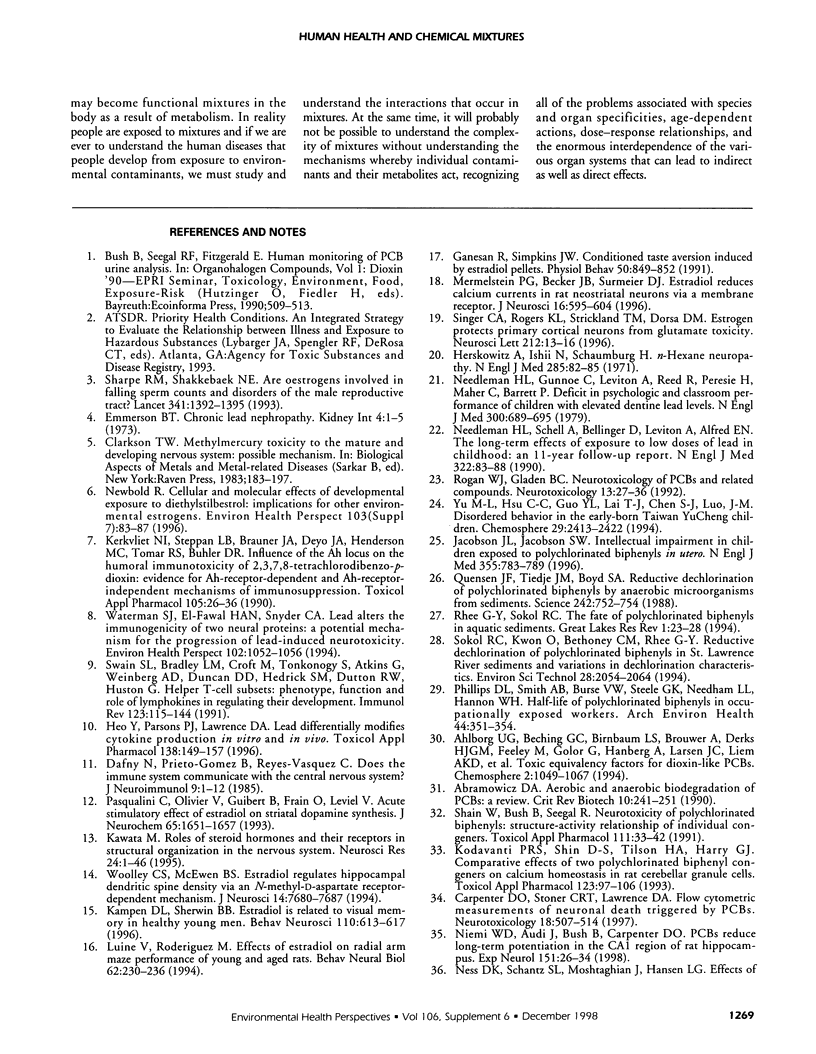
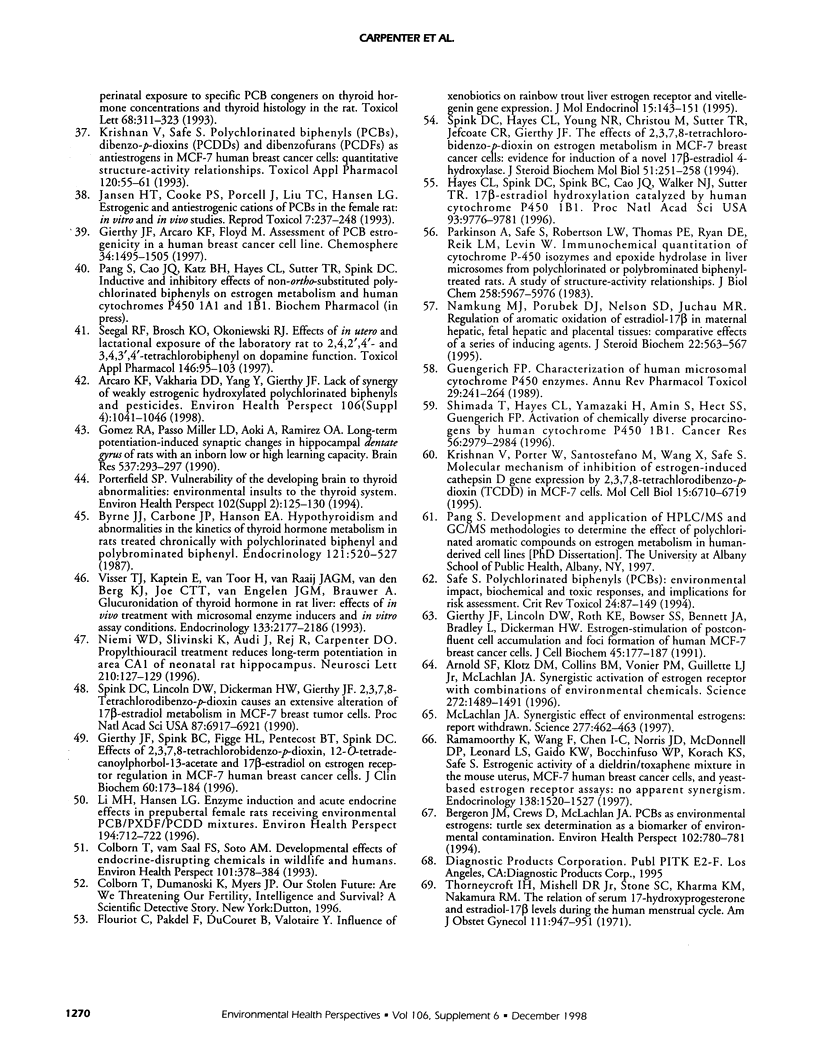
Images in this article
Selected References
These references are in PubMed. This may not be the complete list of references from this article.
- Arcaro K. F., Vakharia D. D., Yang Y., Gierthy J. F. Lack of synergy by mixtures of weakly estrogenic hydroxylated polychlorinated biphenyls and pesticides. Environ Health Perspect. 1998 Aug;106 (Suppl 4):1041–1046. doi: 10.1289/ehp.98106s41041. [DOI] [PMC free article] [PubMed] [Google Scholar]
- Arnold S. F., Klotz D. M., Collins B. M., Vonier P. M., Guillette L. J., Jr, McLachlan J. A. Synergistic activation of estrogen receptor with combinations of environmental chemicals. Science. 1996 Jun 7;272(5267):1489–1492. doi: 10.1126/science.272.5267.1489. [DOI] [PubMed] [Google Scholar]
- Bergeron J. M., Crews D., McLachlan J. A. PCBs as environmental estrogens: turtle sex determination as a biomarker of environmental contamination. Environ Health Perspect. 1994 Sep;102(9):780–781. doi: 10.1289/ehp.94102780. [DOI] [PMC free article] [PubMed] [Google Scholar]
- Byrne J. J., Carbone J. P., Hanson E. A. Hypothyroidism and abnormalities in the kinetics of thyroid hormone metabolism in rats treated chronically with polychlorinated biphenyl and polybrominated biphenyl. Endocrinology. 1987 Aug;121(2):520–527. doi: 10.1210/endo-121-2-520. [DOI] [PubMed] [Google Scholar]
- Carpenter D. O., Stoner C. R., Lawrence D. A. Flow cytometric measurements of neuronal death triggered by PCBs. Neurotoxicology. 1997;18(2):507–513. [PubMed] [Google Scholar]
- Colborn T., vom Saal F. S., Soto A. M. Developmental effects of endocrine-disrupting chemicals in wildlife and humans. Environ Health Perspect. 1993 Oct;101(5):378–384. doi: 10.1289/ehp.93101378. [DOI] [PMC free article] [PubMed] [Google Scholar]
- Dafny N., Prieto-Gomez B., Reyes-Vazquez C. Does the immune system communicate with the central nervous system? Interferon modifies central nervous activity. J Neuroimmunol. 1985 Jul;9(1-2):1–12. doi: 10.1016/s0165-5728(85)80002-3. [DOI] [PubMed] [Google Scholar]
- Emmerson B. T. Chronic lead nephropathy. Kidney Int. 1973 Jul;4(1):1–5. doi: 10.1038/ki.1973.73. [DOI] [PubMed] [Google Scholar]
- Flouriot G., Pakdel F., Ducouret B., Valotaire Y. Influence of xenobiotics on rainbow trout liver estrogen receptor and vitellogenin gene expression. J Mol Endocrinol. 1995 Oct;15(2):143–151. doi: 10.1677/jme.0.0150143. [DOI] [PubMed] [Google Scholar]
- Ganesan R., Simpkins J. W. Conditioned taste aversion induced by estradiol pellets. Physiol Behav. 1991 Oct;50(4):849–852. doi: 10.1016/0031-9384(91)90029-n. [DOI] [PubMed] [Google Scholar]
- Gierthy J. F., Arcaro K. F., Floyd M. Assessment of PCB estrogenicity in a human breast cancer cell line. Chemosphere. 1997 Mar-Apr;34(5-7):1495–1505. doi: 10.1016/s0045-6535(97)00446-3. [DOI] [PubMed] [Google Scholar]
- Gierthy J. F., Lincoln D. W., 2nd, Roth K. E., Bowser S. S., Bennett J. A., Bradley L., Dickerman H. W. Estrogen-stimulation of postconfluent cell accumulation and foci formation of human MCF-7 breast cancer cells. J Cell Biochem. 1991 Feb;45(2):177–187. doi: 10.1002/jcb.240450209. [DOI] [PubMed] [Google Scholar]
- Gierthy J. F., Spink B. C., Figge H. L., Pentecost B. T., Spink D. C. Effects of 2,3,7,8-tetrachlorodibenzo-p-dioxin, 12-O-tetradecanoylphorbol-13-acetate and 17 beta-estradiol on estrogen receptor regulation in MCF-7 human breast cancer cells. J Cell Biochem. 1996 Feb;60(2):173–184. doi: 10.1002/(sici)1097-4644(19960201)60:2<173::aid-jcb2>3.0.co;2-u. [DOI] [PubMed] [Google Scholar]
- Guengerich F. P. Characterization of human microsomal cytochrome P-450 enzymes. Annu Rev Pharmacol Toxicol. 1989;29:241–264. doi: 10.1146/annurev.pa.29.040189.001325. [DOI] [PubMed] [Google Scholar]
- Gómez R. A., Pozzo Miller L. D., Aoki A., Ramírez O. A. Long-term potentiation-induced synaptic changes in hippocampal dentate gyrus of rats with an inborn low or high learning capacity. Brain Res. 1990 Dec 24;537(1-2):293–297. doi: 10.1016/0006-8993(90)90371-h. [DOI] [PubMed] [Google Scholar]
- Hayes C. L., Spink D. C., Spink B. C., Cao J. Q., Walker N. J., Sutter T. R. 17 beta-estradiol hydroxylation catalyzed by human cytochrome P450 1B1. Proc Natl Acad Sci U S A. 1996 Sep 3;93(18):9776–9781. doi: 10.1073/pnas.93.18.9776. [DOI] [PMC free article] [PubMed] [Google Scholar]
- Heo Y., Parsons P. J., Lawrence D. A. Lead differentially modifies cytokine production in vitro and in vivo. Toxicol Appl Pharmacol. 1996 May;138(1):149–157. doi: 10.1006/taap.1996.0108. [DOI] [PubMed] [Google Scholar]
- Herskowitz A., Ishii N., Schaumburg H. N-hexane neuropathy. A syndrome occurring as a result of industrial exposure. N Engl J Med. 1971 Jul 8;285(2):82–85. doi: 10.1056/NEJM197107082850204. [DOI] [PubMed] [Google Scholar]
- Jacobson J. L., Jacobson S. W. Intellectual impairment in children exposed to polychlorinated biphenyls in utero. N Engl J Med. 1996 Sep 12;335(11):783–789. doi: 10.1056/NEJM199609123351104. [DOI] [PubMed] [Google Scholar]
- Jansen H. T., Cooke P. S., Porcelli J., Liu T. C., Hansen L. G. Estrogenic and antiestrogenic actions of PCBs in the female rat: in vitro and in vivo studies. Reprod Toxicol. 1993 May-Jun;7(3):237–248. doi: 10.1016/0890-6238(93)90230-5. [DOI] [PubMed] [Google Scholar]
- Kampen D. L., Sherwin B. B. Estradiol is related to visual memory in healthy young men. Behav Neurosci. 1996 Jun;110(3):613–617. doi: 10.1037//0735-7044.110.3.613. [DOI] [PubMed] [Google Scholar]
- Kawata M. Roles of steroid hormones and their receptors in structural organization in the nervous system. Neurosci Res. 1995 Dec;24(1):1–46. doi: 10.1016/0168-0102(96)81278-8. [DOI] [PubMed] [Google Scholar]
- Kerkvliet N. I., Steppan L. B., Brauner J. A., Deyo J. A., Henderson M. C., Tomar R. S., Buhler D. R. Influence of the Ah locus on the humoral immunotoxicity of 2,3,7,8-tetrachlorodibenzo-p-dioxin: evidence for Ah-receptor-dependent and Ah-receptor-independent mechanisms of immunosuppression. Toxicol Appl Pharmacol. 1990 Aug;105(1):26–36. doi: 10.1016/0041-008x(90)90356-y. [DOI] [PubMed] [Google Scholar]
- Kodavanti P. R., Shin D. S., Tilson H. A., Harry G. J. Comparative effects of two polychlorinated biphenyl congeners on calcium homeostasis in rat cerebellar granule cells. Toxicol Appl Pharmacol. 1993 Nov;123(1):97–106. doi: 10.1006/taap.1993.1226. [DOI] [PubMed] [Google Scholar]
- Krishnan V., Porter W., Santostefano M., Wang X., Safe S. Molecular mechanism of inhibition of estrogen-induced cathepsin D gene expression by 2,3,7,8-tetrachlorodibenzo-p-dioxin (TCDD) in MCF-7 cells. Mol Cell Biol. 1995 Dec;15(12):6710–6719. doi: 10.1128/mcb.15.12.6710. [DOI] [PMC free article] [PubMed] [Google Scholar]
- Krishnan V., Safe S. Polychlorinated biphenyls (PCBs), dibenzo-p-dioxins (PCDDs), and dibenzofurans (PCDFs) as antiestrogens in MCF-7 human breast cancer cells: quantitative structure-activity relationships. Toxicol Appl Pharmacol. 1993 May;120(1):55–61. doi: 10.1006/taap.1993.1086. [DOI] [PubMed] [Google Scholar]
- Li M. H., Hansen L. G. Enzyme induction and acute endocrine effects in prepubertal female rats receiving environmental PCB/PCDF/PCDD mixtures. Environ Health Perspect. 1996 Jul;104(7):712–722. doi: 10.1289/ehp.96104712. [DOI] [PMC free article] [PubMed] [Google Scholar]
- Luine V., Rodriguez M. Effects of estradiol on radial arm maze performance of young and aged rats. Behav Neural Biol. 1994 Nov;62(3):230–236. doi: 10.1016/s0163-1047(05)80021-4. [DOI] [PubMed] [Google Scholar]
- McLachlan J. A. Synergistic effect of environmental estrogens: report withdrawn. Science. 1997 Jul 25;277(5325):462–463. doi: 10.1126/science.277.5325.459d. [DOI] [PubMed] [Google Scholar]
- Mermelstein P. G., Becker J. B., Surmeier D. J. Estradiol reduces calcium currents in rat neostriatal neurons via a membrane receptor. J Neurosci. 1996 Jan 15;16(2):595–604. doi: 10.1523/JNEUROSCI.16-02-00595.1996. [DOI] [PMC free article] [PubMed] [Google Scholar]
- Namkung M. J., Porubek D. J., Nelson S. D., Juchau M. R. Regulation of aromatic oxidation of estradiol-17 beta in maternal hepatic, fetal hepatic and placental tissues: comparative effects of a series of inducing agents. J Steroid Biochem. 1985 Apr;22(4):563–567. doi: 10.1016/0022-4731(85)90179-7. [DOI] [PubMed] [Google Scholar]
- Needleman H. L., Gunnoe C., Leviton A., Reed R., Peresie H., Maher C., Barrett P. Deficits in psychologic and classroom performance of children with elevated dentine lead levels. N Engl J Med. 1979 Mar 29;300(13):689–695. doi: 10.1056/NEJM197903293001301. [DOI] [PubMed] [Google Scholar]
- Needleman H. L., Schell A., Bellinger D., Leviton A., Allred E. N. The long-term effects of exposure to low doses of lead in childhood. An 11-year follow-up report. N Engl J Med. 1990 Jan 11;322(2):83–88. doi: 10.1056/NEJM199001113220203. [DOI] [PubMed] [Google Scholar]
- Ness D. K., Schantz S. L., Moshtaghian J., Hansen L. G. Effects of perinatal exposure to specific PCB congeners on thyroid hormone concentrations and thyroid histology in the rat. Toxicol Lett. 1993 Jun;68(3):311–323. doi: 10.1016/0378-4274(93)90023-q. [DOI] [PubMed] [Google Scholar]
- Newbold R. Cellular and molecular effects of developmental exposure to diethylstilbestrol: implications for other environmental estrogens. Environ Health Perspect. 1995 Oct;103 (Suppl 7):83–87. doi: 10.1289/ehp.95103s783. [DOI] [PMC free article] [PubMed] [Google Scholar]
- Niemi W. D., Audi J., Bush B., Carpenter D. O. PCBs reduce long-term potentiation in the CA1 region of rat hippocampus. Exp Neurol. 1998 May;151(1):26–34. doi: 10.1006/exnr.1998.6793. [DOI] [PubMed] [Google Scholar]
- Niemi W. D., Slivinski K., Audi J., Rej R., Carpenter D. O. Propylthiouracil treatment reduces long-term potentiation in area CA1 of neonatal rat hippocampus. Neurosci Lett. 1996 May 31;210(2):127–129. doi: 10.1016/0304-3940(96)12676-8. [DOI] [PubMed] [Google Scholar]
- Parkinson A., Safe S. H., Robertson L. W., Thomas P. E., Ryan D. E., Reik L. M., Levin W. Immunochemical quantitation of cytochrome P-450 isozymes and epoxide hydrolase in liver microsomes from polychlorinated or polybrominated biphenyl-treated rats. A study of structure-activity relationships. J Biol Chem. 1983 May 10;258(9):5967–5976. [PubMed] [Google Scholar]
- Pasqualini C., Olivier V., Guibert B., Frain O., Leviel V. Acute stimulatory effect of estradiol on striatal dopamine synthesis. J Neurochem. 1995 Oct;65(4):1651–1657. doi: 10.1046/j.1471-4159.1995.65041651.x. [DOI] [PubMed] [Google Scholar]
- Porterfield S. P. Vulnerability of the developing brain to thyroid abnormalities: environmental insults to the thyroid system. Environ Health Perspect. 1994 Jun;102 (Suppl 2):125–130. doi: 10.1289/ehp.94102125. [DOI] [PMC free article] [PubMed] [Google Scholar]
- Quensen J. F., 3rd, Tiedje J. M., Boyd S. A. Reductive dechlorination of polychlorinated biphenyls by anaerobic microorganisms from sediments. Science. 1988 Nov 4;242(4879):752–754. doi: 10.1126/science.242.4879.752. [DOI] [PubMed] [Google Scholar]
- Ramamoorthy K., Wang F., Chen I. C., Norris J. D., McDonnell D. P., Leonard L. S., Gaido K. W., Bocchinfuso W. P., Korach K. S., Safe S. Estrogenic activity of a dieldrin/toxaphene mixture in the mouse uterus, MCF-7 human breast cancer cells, and yeast-based estrogen receptor assays: no apparent synergism. Endocrinology. 1997 Apr;138(4):1520–1527. doi: 10.1210/endo.138.4.5056. [DOI] [PubMed] [Google Scholar]
- Rogan W. J., Gladen B. C. Neurotoxicology of PCBs and related compounds. Neurotoxicology. 1992 Spring;13(1):27–35. [PubMed] [Google Scholar]
- Safe S. H. Polychlorinated biphenyls (PCBs): environmental impact, biochemical and toxic responses, and implications for risk assessment. Crit Rev Toxicol. 1994;24(2):87–149. doi: 10.3109/10408449409049308. [DOI] [PubMed] [Google Scholar]
- Seegal R. F., Brosch K. O., Okoniewski R. J. Effects of in utero and lactational exposure of the laboratory rat to 2,4,2',4'- and 3,4,3',4'-tetrachlorobiphenyl on dopamine function. Toxicol Appl Pharmacol. 1997 Sep;146(1):95–103. doi: 10.1006/taap.1997.8226. [DOI] [PubMed] [Google Scholar]
- Shain W., Bush B., Seegal R. Neurotoxicity of polychlorinated biphenyls: structure-activity relationship of individual congeners. Toxicol Appl Pharmacol. 1991 Oct;111(1):33–42. doi: 10.1016/0041-008x(91)90131-w. [DOI] [PubMed] [Google Scholar]
- Sharpe R. M., Skakkebaek N. E. Are oestrogens involved in falling sperm counts and disorders of the male reproductive tract? Lancet. 1993 May 29;341(8857):1392–1395. doi: 10.1016/0140-6736(93)90953-e. [DOI] [PubMed] [Google Scholar]
- Shimada T., Hayes C. L., Yamazaki H., Amin S., Hecht S. S., Guengerich F. P., Sutter T. R. Activation of chemically diverse procarcinogens by human cytochrome P-450 1B1. Cancer Res. 1996 Jul 1;56(13):2979–2984. [PubMed] [Google Scholar]
- Singer C. A., Rogers K. L., Strickland T. M., Dorsa D. M. Estrogen protects primary cortical neurons from glutamate toxicity. Neurosci Lett. 1996 Jul 5;212(1):13–16. doi: 10.1016/0304-3940(96)12760-9. [DOI] [PubMed] [Google Scholar]
- Spink D. C., Hayes C. L., Young N. R., Christou M., Sutter T. R., Jefcoate C. R., Gierthy J. F. The effects of 2,3,7,8-tetrachlorodibenzo-p-dioxin on estrogen metabolism in MCF-7 breast cancer cells: evidence for induction of a novel 17 beta-estradiol 4-hydroxylase. J Steroid Biochem Mol Biol. 1994 Dec;51(5-6):251–258. doi: 10.1016/0960-0760(94)90037-x. [DOI] [PubMed] [Google Scholar]
- Spink D. C., Lincoln D. W., 2nd, Dickerman H. W., Gierthy J. F. 2,3,7,8-Tetrachlorodibenzo-p-dioxin causes an extensive alteration of 17 beta-estradiol metabolism in MCF-7 breast tumor cells. Proc Natl Acad Sci U S A. 1990 Sep;87(17):6917–6921. doi: 10.1073/pnas.87.17.6917. [DOI] [PMC free article] [PubMed] [Google Scholar]
- Swain S. L., Bradley L. M., Croft M., Tonkonogy S., Atkins G., Weinberg A. D., Duncan D. D., Hedrick S. M., Dutton R. W., Huston G. Helper T-cell subsets: phenotype, function and the role of lymphokines in regulating their development. Immunol Rev. 1991 Oct;123:115–144. doi: 10.1111/j.1600-065x.1991.tb00608.x. [DOI] [PubMed] [Google Scholar]
- Thorneycroft I. H., Mishell D. R., Jr, Stone S. C., Kharma K. M., Nakamura R. M. The relation of serum 17-hydroxyprogesterone and estradiol-17-beta levels during the human menstrual cycle. Am J Obstet Gynecol. 1971 Dec 1;111(7):947–951. doi: 10.1016/0002-9378(71)90951-3. [DOI] [PubMed] [Google Scholar]
- Visser T. J., Kaptein E., van Toor H., van Raaij J. A., van den Berg K. J., Joe C. T., van Engelen J. G., Brouwer A. Glucuronidation of thyroid hormone in rat liver: effects of in vivo treatment with microsomal enzyme inducers and in vitro assay conditions. Endocrinology. 1993 Nov;133(5):2177–2186. doi: 10.1210/endo.133.5.8404669. [DOI] [PubMed] [Google Scholar]
- Waterman S. J., el-Fawal H. A., Snyder C. A. Lead alters the immunogenicity of two neural proteins: a potential mechanism for the progression of lead-induced neurotoxicity. Environ Health Perspect. 1994 Dec;102(12):1052–1056. doi: 10.1289/ehp.941021052. [DOI] [PMC free article] [PubMed] [Google Scholar]
- Woolley C. S., McEwen B. S. Estradiol regulates hippocampal dendritic spine density via an N-methyl-D-aspartate receptor-dependent mechanism. J Neurosci. 1994 Dec;14(12):7680–7687. doi: 10.1523/JNEUROSCI.14-12-07680.1994. [DOI] [PMC free article] [PubMed] [Google Scholar]
- Yu M. L., Hsu C. C., Guo Y. L., Lai T. J., Chen S. J., Luo J. M. Disordered behavior in the early-born Taiwan Yucheng children. Chemosphere. 1994 Nov-Dec;29(9-11):2413–2422. doi: 10.1016/0045-6535(94)90410-3. [DOI] [PubMed] [Google Scholar]




